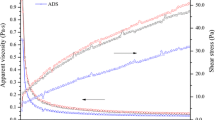Abstract
Rheological characterization of sludge is known to be an essential tool to optimize flow, mixing and other process parameters in wastewater treatment plants. This study deals with the characterization of thickened excess activated sludge in comparison to raw primary sludge and excess activated sludge. The effects of key parameters (total solid concentration, temperature, and pH) on the rheology and flow behavior of thickened excess activated sludge were studied. The rheological investigations were carried out for total solid concentration range of 0.9–3.7 %w/w, temperature range of 23–55 °C, and pH range of 3.6–10.0. Different rheological model equations were fitted to the experimental data. The model equations with better fitting were used to calculate the yield stress, apparent, zero-rate, infinite-rate viscosities, flow consistency index, and flow index. The decrease in concentration from 3.7 to 3.1 %w/w resulted in a drastic reduction of yield stress from 27.6 to 11.0 Pa, while a further reduction of yield stress to 1.3 Pa was observed as solid concentration was reduced to 1.3 %w/w. The viscosity at higher shear rate (>600 s−1) decreased from 0.05 Pa·s down to 0.008 Pa·s when the total solid concentration was reduced from 3.7 to 0.9 %. Yield stress decreased from 20.1 Pa down to 8.3 Pa for the Bingham plastic model when the temperature was raised from 25 to 55 °C. Activation energy and viscosity also showed decreasing trends with increasing temperature. Yield stress of thickened excess activated sludge increased from a value of 6.0 Pa to 8.3 Pa when the pH was increased from 3.6 to 10.0. The effect of polymer dose on the rheological behavior of the thickening of excess activated sludge was also investigated, and the optimum polymer dosage for enhanced thickener performance was determined to be 1.3 kg/ton DS.










Similar content being viewed by others
References
N. Ratkovich, W. Horn, F.P. Helmus, S. Rosenberger, W. Naessens, I. Nopens, T.R. Bentzen, Water Res. 47, 2 (2013)
F. Clauss, D. Helaine, C. Balavoine, A. Bidault, Water Sci. Technol. 38, 8–9 (1998)
P. Trávníček and P. Junga J. Environ. Health Sci. Eng. 12 (2014)
I. Seyssiecq, J.-H. Ferrasse, N. Roche, Biochem. Eng. J. 16, 1 (2003)
F. Markis, J.-C. Baudez, R. Parthasarathy, P. Slatter and N. Eshtiaghi Chem. Eng. J. 253 (2014)
B. Abu-Jdayil, F. Banat, M. Al-Sameraiy, J. Water Resour. Prot. 2, 1 (2010)
Baroutian, N. Eshtiaghi and D.J. Gapes Bioresour. Technol. 140 (2013)
E. Farno, R. Parthasarathy, J.C. Baudez and N. Eshtiaghi, in Chemeca 2013(2013)
F.D. Sanin, Water SA 28, 2 (2002)
L. Piani, C.B. Rizzardini, A. Papo and D. Goi Sci. World J. (2014)
N. Eshtiaghi, F. Markis, S.D. Yap, J.-C. Baudez, P. Slatter, Water Res. 47, 15 (2013)
H. Hasar, C. Kinaci, A. Ünlü, H. Toǧrul, U. Ipek, Biochem. Eng. J. 20, 1 (2004)
B. Liao, D. Allen, G. Leppard, I. Droppo, S. Liss, J. Colloid Interface Sci. 249, 2 (2002)
E. Neyens, J. Baeyens, R. Dewil, B. De heyder, J. Hazard. Mater. 106, 2–3 (2004)
B. Örmeci, Water Res. 41, 6 (2007)
A. American Public Health, A. American Water Works, F. Water Pollution Control and F. Water environment, standard methods for the examination of water and wastewater, American Public Health Association (2005)
H. Li, Y. Jin, R. Mahar, Z. Wang, Y. Nie, Bioresour. Technol. 99, 11 (2008)
V. Lotito and A.M. Lotito J. Environ. Manage. 137 (2014)
A. Björn, A. Karlsson, B.H. Svensson, J. Ejlertsson, P.S. de La Monja, Rheological characterization (InTech, Rijeka, Croatia, 2012)
L.I. Sokolov, Life Sci. J. 10, 4 (2013)
M. Mori, I. Seyssiecq, N. Roche, Process Biochem. 41, 7 (2006)
A.H. Khalili Garakani, N. Mostoufi, F. Sadeghi, M. Hosseinzadeh, H. Fatourechi, M.H. Sarrafzadeh, M.R. Mehrnia, Iran J. Environ. Health Sci. Eng. 8, 3 (2011)
M.A. Rao, Rheology of fluid and semisolid foods: principles and applications: principles and applications (Springer, Berlin, 2010)
L. Spinosa, V. Lotito, Adv. Environ. Res. 7, 3 (2003)
L. Appels, J. Degrève, B. Van der Bruggen, J. Van Impe, R. Dewil, Bioresour. Technol. 101, 15 (2010)
E. Paul, P. Camacho, D. Lefebvre, P. Ginestet, Water Sci. Technol. 54, 5 (2006)
O. Manoliadis, P.L. Bishop, J. Environ. Eng. 110, 1 (1984)
M.W. Tenney, W. Stumm, J Water Pollut Control Fed 37, 10 (1965)
P.T. Spicer, S.E. Pratsinis, Water Res. 30, 5 (1996)
Acknowledgments
The authors acknowledge the Water Corporation, Perth, WA, for providing onsite laboratory space and funding the project (Project Agreement No. 008). The authors also acknowledge the Department of Chemical Engineering of Curtin University, Perth, for proving the necessary research infrastructure and equipment/instruments and financial support.
Author information
Authors and Affiliations
Corresponding author
Rights and permissions
About this article
Cite this article
Hong, E., Yeneneh, A.M., Kayaalp, A. et al. Rheological characteristics of municipal thickened excess activated sludge (TEAS): impacts of pH, temperature, solid concentration and polymer dose. Res Chem Intermed 42, 6567–6585 (2016). https://doi.org/10.1007/s11164-016-2482-2
Received:
Accepted:
Published:
Issue Date:
DOI: https://doi.org/10.1007/s11164-016-2482-2




